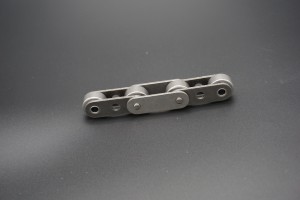Heat treatment of roller chains: technology, process and application
Introduction
As a key component widely used in the field of mechanical transmission, the performance of roller chains directly affects the operating efficiency and reliability of mechanical equipment. Heat treatment is a crucial link in the manufacturing process of roller chains. By precisely controlling the heating and cooling process, the strength, hardness, wear resistance and fatigue life of roller chains can be significantly improved. This article will explore the heat treatment technology of roller chains in depth, including common heat treatment processes, process parameter optimization, equipment selection and quality control, aiming to provide international wholesale buyers with comprehensive and in-depth technical references to help them better understand the heat treatment process of roller chains and make more informed purchasing decisions.
Heat treatment process of roller chains
There are many heat treatment processes for roller chains, each of which has its own unique characteristics and applicable scenarios. The following are several common heat treatment processes:
Quenching process
Quenching is a common process for improving the hardness and strength of roller chains. The specific steps are as follows:
Heating: Heat the roller chain to an appropriate temperature, usually between 800-850℃.
Insulation: After reaching the quenching temperature, keep it for a certain time to make the internal temperature of the chain uniform.
Quenching: The chain is quickly immersed in the quenching medium, such as cold water, oil or salt water. During the rapid cooling process, hardened tissue will form on the surface and inside of the chain.
Tempering: In order to reduce the internal stress generated during the quenching process and increase the toughness of the chain, tempering treatment is usually performed.
Hardening process
The hardening process improves the hardness and wear resistance by improving the internal structure of the roller chain. The specific steps are as follows:
Heating: Heat the chain to the hardening temperature to dissolve and diffuse the carbon, nitrogen and other elements in the chain.
Insulation: After reaching the hardening temperature, keep a certain insulation time to make the elements diffuse evenly and form a solid solution.
Cooling: Rapidly cool the chain, the solid solution will form a fine grain structure, improve the hardness and wear resistance.
Carbonitriding process
Carbonitriding is a process to improve the surface hardness and wear resistance of roller chains, mainly used for special materials such as stainless steel chains. The specific steps are as follows:
Heating: Heat the chain and the carbon and nitrogen source to the co-carburizing temperature and keep it for a certain time. The carbon and nitrogen on the surface of the chain will diffuse into the inside to form a co-carburizing layer.
Quenching: The chain after the carburizing layer is formed is quickly immersed in the quenching medium and cooled rapidly to solidify the carburizing layer and increase the hardness.
Tempering: In order to reduce the internal stress generated during the quenching process and increase the toughness of the chain, tempering treatment is usually performed.
Liquid carburizing process
Liquid carburizing is a process to improve the surface hardness and wear resistance of the roller chain, which is usually suitable for carbon steel chains. The specific steps are as follows:
Heating: Heat the chain to the liquid carburizing temperature, and determine the specific temperature according to the material and requirements of the chain.
Carburizing: Immerse the chain in a carburizing medium, such as sodium cyanide solution, and carburize for a certain period of time.
Quenching: The carburized chain is quickly immersed in the quenching medium and cooled rapidly to solidify the carburized layer and increase the hardness.
Tempering: In order to reduce the internal stress generated during the quenching process and increase the toughness of the chain, tempering treatment is usually performed.
Optimization of heat treatment process parameters
The optimization of heat treatment process parameters is crucial to ensure the performance of roller chains. The following are some key parameters and their optimization methods:
Quenching temperature and time
The quenching temperature is usually controlled between 800-850℃, and the specific temperature needs to be adjusted according to the chain material and process requirements. The holding time is generally 30-60 minutes to ensure uniform temperature inside the chain.
Quenching medium selection
The selection of quenching medium depends on the material and performance requirements of the chain. Cold water has a fast cooling speed and is suitable for chains requiring high hardness; oil has a relatively slow cooling speed and is suitable for chains requiring toughness.
Tempering temperature and time
The tempering temperature is generally between 200-300℃, and the holding time is usually 1-2 hours. The selection of tempering temperature and time needs to be adjusted according to the final use requirements of the chain to achieve the best balance between toughness and hardness.
Heat treatment equipment selection
Choosing the right heat treatment equipment is crucial to improving production efficiency and product quality. Common heat treatment equipment includes:
Quenching equipment
Bright annealing furnace: suitable for roller chains with high surface quality requirements.
Converter: suitable for large-scale production, can ensure the uniformity of the quenching process.
Carburizing equipment
Mesh belt furnace: suitable for continuous production, can accurately control carburizing time and temperature.
Tempering equipment
Multi-purpose heat treatment furnace: can perform quenching and tempering treatment at the same time to improve production efficiency.
Quality control and testing
The roller chain after heat treatment needs strict quality control and testing to ensure that its performance meets the design requirements. Common testing methods include:
Hardness testing
Hardness testing is an important means to evaluate the heat treatment effect of roller chains. Rockwell hardness tester or Vickers hardness tester is usually used to test the surface hardness and core hardness of the chain.
Post time: Apr-11-2025

